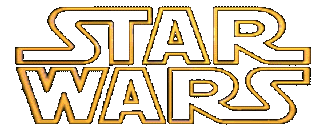Toybashing!
toybashing (toi • băsh • ĭng) v. 1. The art of constructing new toys from parts of old toys. Derived from "kit-bashing" (q.v.).
F.A.Q.
Q: Are these for sale?
A: No
Q: No really, I'll pay a lot.
A: Really, no. I like having them. It's cool to have the only one of something on the planet.
Q: Can you make me one?
A: No - I don't have time. I'm only typing up these answers because I'm on vacation.
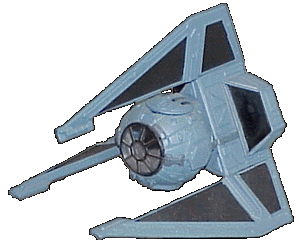 TIE Phantom
TIE Phantom
Media: One Galoob Action Fleet™ TIE Interceptor.
Tools: 1/8" styrene, 1/32" styrene, 1/32" transparent styrene, cyanoacrylate glue, hobby knife, hobby saw, model filler, sandpaper, spray
enamel, model paint. Vague instructions
Notes: The TIE Phantom (TIE/P) is a hypothetical design based on the standard TIE cockpit and the body design from the V-38 "Phantom TIE" ships in the LucasArts game Rebel Assault II. The ships in the game have a truncated cone-shaped cockpit, seat two with life support, and feature a cloaking device. My TIE/P is intended to represent a production model incorporating the cloaking technology united with standard TIE fabrication methodology.
Oh, and yeah, it's a Tri-Ion-Engine ship, not a Twin-Ion-Engine ship. And no, I do not know how the pilot gets the hatch open. In Rebel
Assault II the ship has an elevator, but maybe this one's sphere flips down to allow access to the cloak machinery in the aft hull
area.
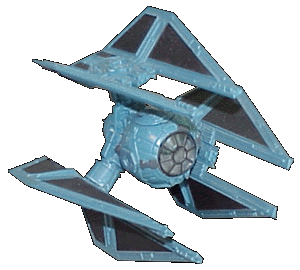 TIE Defender
TIE Defender
Media: Two Galoob Action Fleet™ TIE Interceptors.
Tools: cyanoacrylate glue, sharp hobby knife, pliers, screwdriver.
Notes: The TIE Defender design is from the LucasArts simulation game TIE Fighter I'm not too crazy about how the ships look in the game, but the schematic depiction in Star Wars Guide to Vessels and Vehicles has a very TIE Interceptor-esque design and that appeals to me. The panels do not have the rear-center solar panel segment removed because I don't have any tools which could do that without mangling the wings. I think it looks good though.
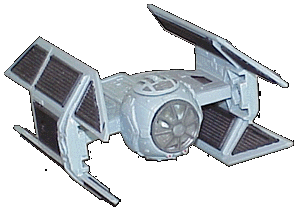 TIE Advanced
TIE Advanced
Media: One Galoob Action Fleet™ Darth Vader's TIE Fighter.
Tools: cyanoacrylate glue, hobby knife, 1/32" styrene, sand paper, hobby filler, screwdriver, model paint.
Notes: The TIE Advanced design is from the LucasArts simulation game TIE Fighter. It's supposed to be a later production version
of Vader's TIE. After X-Wing vs. TIE Fighter came out, the shape of the wings was clarified (the back angle is identical to
Vader's tie, only the front is sharper) so I redid the wings, and it looks much better now.
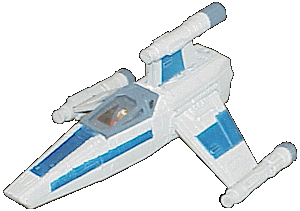 T-Wing
T-Wing
Media: One Galoob Action Fleet™ X-Wing
Tools: cyanoacrylate glue, hobby knife, hobby saw, sand paper, hobby filler, screwdriver, lots and lots of model paint.
Notes: The T-Wing design is from the LucasArts simulation game X-Wing vs. TIE Fighter. This one took a fair bit of work to convert from an X-Wing, but I think it turned out really well. That I could get the landing gear working again is an added bonus. This one was much harder than it looks; the nose is very different from the X-Wing if you stare at it for long enough. It doesn't have a "snub-nose" for one thing, and it tapers much more quickly once you account for that.
I think this is the one I'm happiest with, but the TIE Drone is a close second...
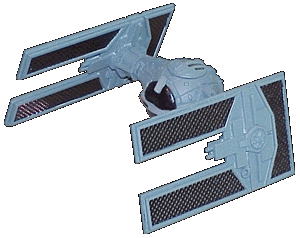 TIE Drone
TIE Drone
Media: One Galoob Action Fleet™ TIE Interceptor
Tools: Styrene (sheet, textured sheet, and rods/tubes), cyanoacrylate glue, hobby knife, hobby saw, sand paper, hobby filler, screwdriver,
model paint.
Notes: The TIE Drone (or TIE Droid) is from the Dark Empire comics, is detailed in the Star Wars Guide to Vessels and
Vehicles
and is your adversary in the last level of the LucasArts game Rogue Squadron. The cockpit "window" (theoretically a sensor
array) was the hardest part - I couldn't find a curved bit of plastic that was "just right" so I molded it out of oven-cured modeling clay.
It would inevitably stretch and warp between getting taking out from between the cockpit halves and onto the cookie sheet, but I got it
eventually. The upper hatch opens to reveal a narrow access area into the computer's droid brain.
